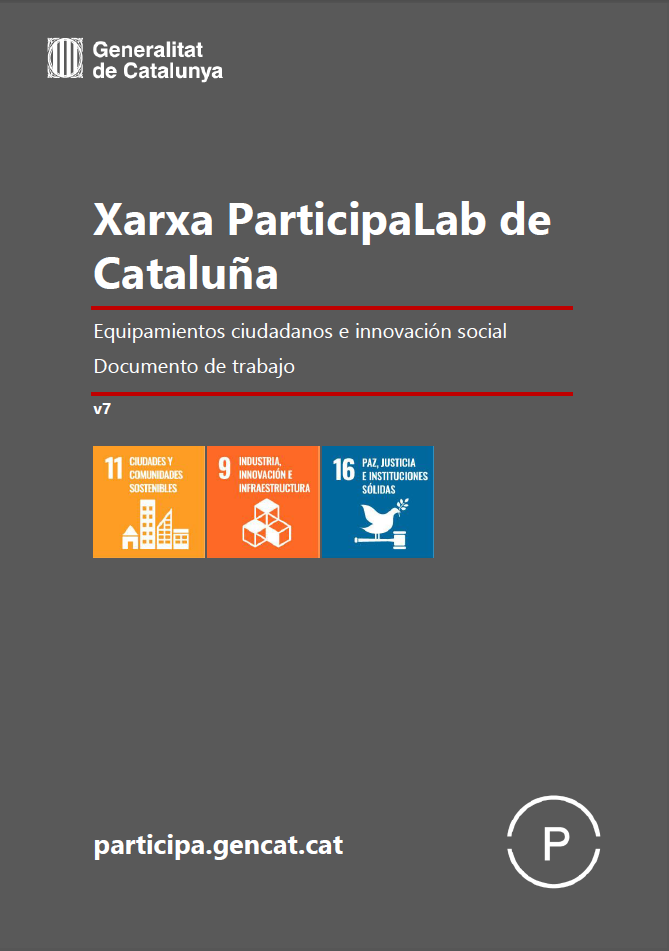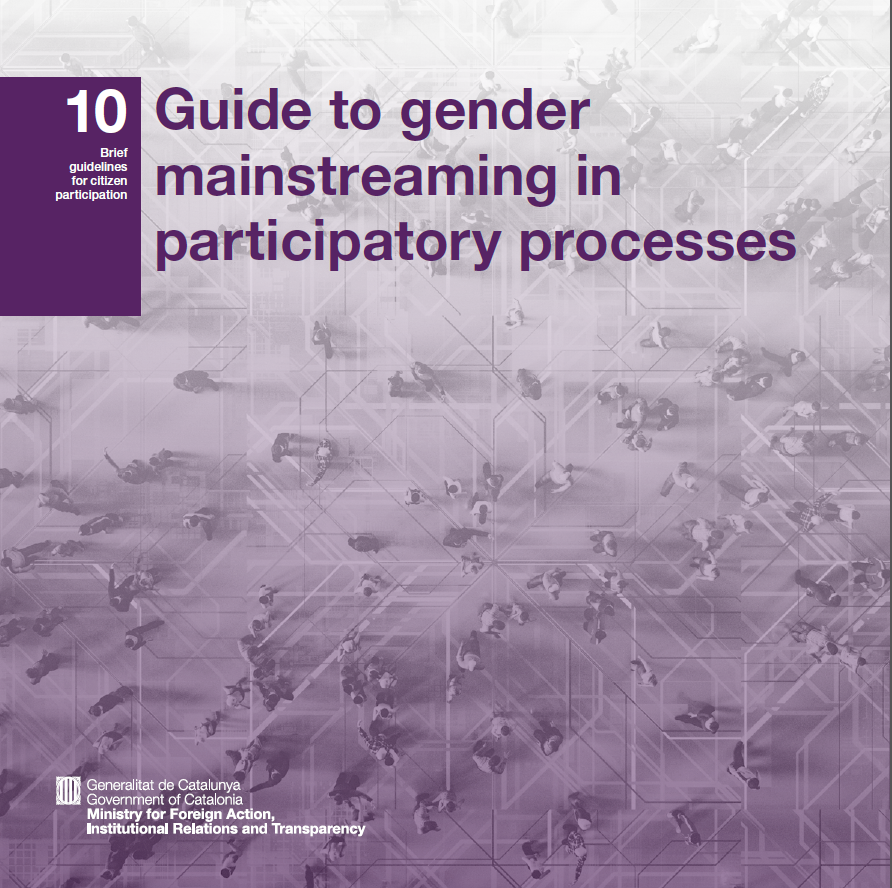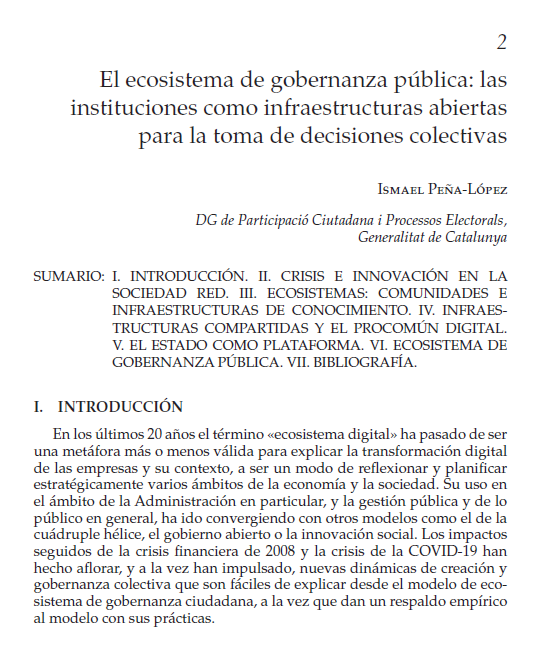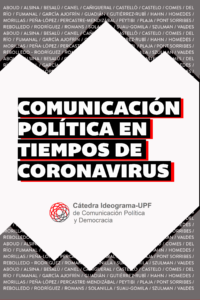Although I had been long interested on gender studies, during December 2018 and the first months of 2019 I began to actively search for documents that dealt with the issue of gender (discrimination, inequality, etc.) on citizen participation. I found out that there was quite a lot of literature on gender and democratic institutions, but nothing specifically on gender mainstreaming in participatory processes.
So, at the Directorate General of Citizen Participation and Electoral Processes we decided to do our own research and project on the issue. With the valuable help of Fundació Surt, and after an initial training, we analyzed public procurement, the facilitation of events, the evaluation processes, information and communication protocols, etc. under the light of gender mainstreaming.
The result was triple. First, the aforementioned analysis and evaluation; second, a set of internal protocols to improve our own work; third, a Guide to gender mainstreaming in participatory processes so that anyone in the field of citizen participation can use and apply in their own citizen participation instruments.
The guide has been published in Catalan and English (see below) and the whole project was distinguished by the IOPD with a special mention in their distinction on the “Best Practice in Citizen Participation”, the award given annually by the International Observatory on Participatory Democracy to recognize public policies implemented by local governments.
Below one can download the guide and access the bibliography I personally used on gender planning and evaluation methodologies in relationship with citizen participation.
Downloads
Bibliography
Berbel Sánchez, S. & Geronès i Rovira, M. (2008). “
Participació política de les dones”. In Bodelón, E. & Giménez, P. (Coords.),
Desenvolupant els drets de les dones: Àmbits d'intervenció de les polítiques de gènere, Capítol 12, 199-231. Col·lecció Estudis, Sèrie Igualtat i Ciutadania, 2. Barcelona: Diputació de Barcelona.
Delatte, M., Guijarro, B., Almirall, J., Llop, N., Adell, H. & Medrano, A. (2018).
Anàlisi de la participació de dones en els espais institucionals i socials mixtos de la ciutat de Barcelona. Barcelona: Ajuntament de Barcelona, Liquen Data Lab.
Ecologistas en Acción (2018).
Patriarcalitest. Madrid: Ecologistas en Acción.
United Nations Human Settlements Programme (2012).
Gender Toolkit. New York: OCHA.
Xarxa d'Economia Solidària de Catalunya (2017b).
Reunions roDONES. Barcelona: XES.
At the beginning of the COVID-19 crisis I wrote about the differential impact of crisis in the Information Society based on the first fact that were quickly becoming evident before our eyes and at plain sight.
Shortly after, professors Josep M. Reniu and Víctor Meseguer led a monography on how the COVID-19 crisis was impacting democratic institutions and what to do about it. The book ¿Política confinada? Nuevas tecnologías y toma de decisiones en un contexto de pandemia [Confined politics? New technologies and decision-making in a pandemic context] focuses on how institutions are responding to a pandemic that keeps people at home or away from each other, and how they are figuring out ways of keeping in touch with citizens and keep performing the tasks they have been committed to.
I wrote a book chapter, the second one, with the aim to provide a wide landscape on how democratic institutions and the democratic arena are configuring themselves, and how the pandemic crisis may be an accelerator to it. On El ecosistema de gobernanza pública: las instituciones como infraestructuras abiertas para la toma de decisiones colectivas [The ecosystem of public governance: institutions as open infrastructures for collective decision-making] I take the idea of the citizen participation ecosystem to a higher level, trying to scale it up to the global public governance level.
To do so, I introduce the concept of ecosystems on social sciences, which have been applied with much success —in my opinion— to describe the quick deployment of digital business infrastructures. I describe such ecosystems as knowledge communities and infrastructures that wrok in open and shared ways, aiming at the building of a digital commons. Following, I review the idea of ‘the state as a platform’, ending up with a definition and proposal of the ecosystem of public governance, which I define as:
A public governance ecosystem is a technopolitical, self-organized, autopoietic, replicable and scalable system that articulates actors, spaces and instruments around a set of open and distributed infrastructures rich on knowledge for collective decision-making.
A preprint of the whole chapter (in Spanish) and the bibliography I used can be accessed below.
Downloads
Bibliography
Chesbrough, H.W. (2003). “
The Era of Open Innovation”. In
MIT Sloan Management Review, Spring 2003, 35-41. Cambridge: MIT Sloan School of Management.
Dini, P., Darking, M., Rathbone, N., Vidal, M., Hernández, P., Ferronato, P., Briscoe, G. & Hendryx, S. (2005).
The Digital Ecosystems Research Vision: 2010 and Beyond. Brussels: European Commission.
Heimstädt, M., Saunderson, F. & Heath, T. (2014). “
Conceptualizing Open Data Ecosystems: A Timeline Analysis of Open Data Development in the UK”. In Parycek, P. & Edelmann, N. (Eds.),
CeDEM14. Proceedings of the International Conference for E-Democracy and Open Government 2014, 245-255. 21-23 May 2014, Danube University Krems, Austria. Krems: Edition Donau-Universität Krems.
Iansiti, M. & Levien, R. (2004). “
Strategy as Ecology”. In
Harvard Business Review, March 1, 2004. Cambridge: Harvard University.
Nachira, F., Nicolai, A., Dini, P., Le Louarn, M. & Rivera León, L. (Eds.) (2007).
Digital Business Ecosystems. Brussels: European Commission.
O’Reilly, T. (2011). “
Government as a Platform”. In
Innovations: Technology, Governance, Globalization, 6 (1), 13-40. Cambridge: MIT Press.
- Identity
- Interests
- Powers
- Reputation
- Representation
- Transactions
- Traceability
- Transparency
Current challenges of online participation
We are in the middle of an interesting perfect storm. Firstly, citizen participation is clearly on the rise, with more citizens demanding being listened to, and more public (and also private) institutions responding to these demands. Secondly, a call for that citizen participation to be accessible, flexible and inclusive, which is boosting online citizen participation as a complement to traditional participation channels and methodologies, thus enabling not only other means different than face-to-face, but also disclosing informal spaces for participation. Thirdly, the appearance or improvement of different kinds of technologies that come to enable or strengthen online communication (P2P networks, distributed ID systems, decentralized ledger technologies, etc.).
In this perfect storm, notwithstanding, we still often see “solutions looking for a problem”. That is, technologies that appear to fill a demand for more participation and more online participation, but that sometimes do not seem to fix the real problems that the online participation arena is having.
On a recent talk about the possibilities of Blockchain I came up not with what could Blockchain do for participation, but what were the main challenges that citizen participation in general, and online participation in particular was facing. And then ask whether technologies could be of any help in the list of challenges.
I here present these challenges by following what in marketing is called a customer journey. I draw an imaginary complete cycle of citizen participation, along which I present the different challenges that this citizen or the whole process finds in its way.
A citizen
A citizen wants to have their say on a given issue. But, who are they? A clear identity of this citizen may be necessary to know whether they belong to a given demos. It is true that some participation processes, especially those based on deliberation —provide as much insights as we can, regardless of representativeness—, may not require identity. But we can also look at identity from the other point of view: not as in “who am I” but no “where do I belong to”, “where do my rights lay” or “who grants me citizen rights”. Identity, thus, is not about voting or paying taxes (only) but about knowing whether I am a citizen with full citizenship.
With some interests
A citizen does not necessary need to be interested in absolutely everything. It may just seem right not to invite him to participate in absolutely everything —some decisions we may think are of their interest despite their own preferences or tastes, like electing representatives: voting is even compulsory in some places—.
Knowing what are someone’s interests, and linking them to their identity may be useful either to explicitly invite a given collective to speak out their opinion, or for a given citizen to filter out what are the options available to speak out.
Individual or Collective
- Identity
- Powers
- Representation
This citizen with some interests, is acting as an individual or as a collective? Is she a single person, or is it an organization? This question is not related with whether a citizen represents someone, but about what different legal frameworks allow to do to e.g. natural persons or to legal persons.
Knowing this difference —not a trivial issue— may be crucial to be able to participate in a given process. People may participate personally within an association, but most of the times only legal persons may be able to participate in a federation of associations.
But, of course, legal persons cannot perform actions, physically speaking: someone, a flesh and bones individual has to perform for them: has to represent them.
And sometimes different people can perform different actions in representation of a collective. That is, the collective can grant different powers to different people. For instance, many can give an opinion, but only one of them can cast a vote or make a binding decision.
So, knowing one’s identity is not enough: we may need to know whether they are representing a collective and, if they are, what can they do on its behalf.
In relationship with someone
- Identity
- Representation
- Transactions
This citizen, now that we can tell whether they are an individual or a collective, and which are their interests, it may be useful to know what are their relationships with other citizens.
A first approach to this is whether they are affiliated, formally or informally, to some other collectives, and what of affiliation or relationship they have with them. Besides the aforementioned issue of representation, the degree or intensity of relationships may be interesting to tell whether a citizen is a leader in their respective sector, and thus consider their participation in a different way.
A second approach, and most relevant here, is whether this relationship is with the Administration: that is, we want to record what kind of exchanges or transactions a given citizen has had with public bodies. This is important at many levels, among them treating the citizen consistently, recording their potential impact on public policies, identify valid interlocutors, publicise these relationships, etc.
Says or does something
Now that we know who the citizen is, what are their interests, whether they are a person or a collective, what kind of powers to represent this collective they have and what have been their relationships with other collectives (especially the Administration), now citizens want to say or do something.
In face-to-face participation — and most especially in formal meetings— minutes are taken or there are at least records of what is being said or done. Same should happen online. This is nevertheless much more complex in the online world: not only, as we have been saying, identity, etc. is more blurry and/or fluid, but there are also different degrees of formality and informality, usually a high diversity of channels which have to be coordinated or at least be made coherent and consistent and provide a comprehensive explanation of what is going on.
What is being said and done online has to be accompanied by the context in which it is being said and done, in the same way as in formal channels, where conversations and performances already follow a given protocol. This means not, of course, having to approve a formal protocol for everything happening online: hence the difficulty of this issue.
Delegates or is endorsed
- Identity
- Powers
- Representation
- Transactions
When saying or doing these things, are citizens acting on their own? Or are they being endorsed by someone? Are they being delegated some other’s opinions or votes? How should we be taking into account this acting individually or collectivelly? Mind that this is a little bit different to representing someone or having been granted some powers. Representation and powers is more about the legal aspects of being empowered to do something. That is: who are you and what can you do on the behalf of someone else. By delegation or endorsement we look at the phenomenon from the other end: how should I, Administration, take into account this acting on behalf of someone? e.g. Representation is how you choose your elected representatives; delegation is how you will take into account their votes at the Parliament. It is a slight difference, but and important one.
But, beyond how you take it into account, we want to know whether this representation is permanent or temporary. Liquid democracy or proxy voting, changes in representation are much more easy in the online world but need being cleverly articulated. There is an increasing way to solve this technologically, but we are far from the best system —if there is such a thing.
Delegating one’s vote will involve identity, what powers am I granting and to say or do what.
In multiple instances and levels
Things that citizens can or want to do or say things. And they want to do or say things to the Administration (or to any other kind of collective), so that they are taken into account and public policies are put to work.
But quite often —and this is especially true with Public Administrations— collectives of people follow a hierarchy: e.g. your municipality’s health system depends on your region’s health system that depends on your state’s health system.
Or, depending on your interests (e.g. the environment and Global Warming), you may want to do or say things on Global Warming to your city council, to your regional government and to your national government. Different things, at different levels, but on a similar issue.
Or. As a public body, you may want to infer the macro policy from the micro policies put at work or suggested at lower Administration levels. For instance, the local strategy on urban mobility will necessarily shape —or will be determined— by the national strategy on mobility.
Can we, by means of technology, make easy the granularization of macro-level policies into micro-level ones? Can we, by means of technology, make easy the inference of micro-level policies into macro-level ones?
This will, in part, depend on who you are and what can you do (powers) at different Administration levels. That is, what are your citizen rights depending on your citizenship considering different demos belong to or different governments that rule your life.
With different weights
- Identity
- Powers
- Reputation
- Representation
We have considered, so far, “one individual, one vote”. But in many cases there this rule could be changed and, instead, grant the citizen with more “votes”, that is, that their voice or decisions or actions have more influence, more weight than de voices or decisions or actions than other citizens’.
The evident application of this differential weighting is, of course, representation and delegation. It may be just common sense that someone representing a organization can have an influence proportional to the people that they are representing, that is, the people that delegated their voice or vote to their representative. Thus, two people representing a huge and a tiny collective, respectively, would have a higher or lesser influence when they participate e.g. in a public consultation.
But we can go one step further. We may want to grant different power of influence to different actors. Some people are directly affected by public decisions while others are only indirectly or partially affected, or even not affected at all. E.g. when considering issuing a new regulation on diabetes, citizens with diabetes will surely be more affected than citizens with no diabetes: weighting their decisions might be taken into consideration.
Or we might even want to weight citizens’ opinions depending on their position in society (e.g. a renowned scholar in the field), what they have done and said before, what people have thought of what they have done or said before, etc. Technologies can not only be helpful in the mere weighting, but in calculating the most appropriate weights.
Revisits or checks actions
- Transactions
- Traceability
- Transparency
So, citizens do or say things, depending on many factors, etc. Once it is done or said, and time goes by, can people, citizens or Administrations, go back and see who said what and why? Can they trace and see the relationships between all the transactions (interactions, exchanges, etc.) done in the past?
Being able to follow the steps being taken is crucial for assessment and evaluation. Policy footprints are important, but they become essential, when complexity increases. And we are not talking here about the complexity of the issue, but about the complexity of the solution and, more specifically, the complexity with which the policy instrument was designed —in our case, with a plurality and diversity of actors, contributions and channels.
And checks how it fits within the overall plan
- Interests
- Powers
- Transactions
- Traceability
- Transparency
Even more, can this traceability be put in context and see what was the impact (not the mere aggregated result) of one single contribution? Can one make this inference from the micro to the macro level?
This aspect is, in my opinion, much more than —I insist— a mere aggregation of individual wills and says.
Checking how each and every piece of opinion, issued in formal or informal ways, scattered across a great diversity of channels and formats, is about finding where are the critical masses what, what are the behavioural patterns are which are the main trends. Which is not a minor thing.
By identifying critical masses, behavioural patterns and main trends we are able to both focus and forecast. By focusing and forecasting, we can become more effective and become more efficient.
Checks for accountability
- Transactions
- Traceability
- Transparency
Beyond fitness in the overall plan, we want to know: what happens afterwards? Can citizens and Administrations follow-up and monitor what use is being made by the ones taking into account (or not) their acts and voices? Can one see the evolution of the progressive triage, acceptance or rejection of proposals, adoption, transformation or improvement, etc. that end up in a final decision or policy? Who ended up doing what? Who took responsibilities?
Accountability brings us back to assessment and evaluation. In this case, not only about how the policy instrument was designed, but how was implemented and put into practice. And, most important, what results did it have and which were the impacts of such results.
Accountability closes the cycle of policy-making, and we can begin again with the diagnosis of the issue or the situation, which brings us back to the who, and back to identity, here taken as a target: who did we impact with our policy and how.
Summing up: current challenges of online citizen participation
As it can be seen, all these issues are very deeply related among them. In my believe, one should not address a single issue (e.g. identity) without addressing the whole journey of a citizen participation process. Identity is defined, also, by representation or delegation, and representation implies taking into consideration weighting or accuntability. An so on.
Thus, the question Will [fill with the name of a technology] contribute or solve the problem of citizen participation?
may not be the correct approach. It may be more useful to ask what specific issues of the process can it contribute to improve and within what mix of other tecnologies. And how will they be merged and inter-operate among them. Which may be the question.
Keynote speech. Chairs: Pere Fabra
Céline Deswarte. Policy Officer, European Commission. Directorate General for Communication, Networks, Content and Technology.
Towards a future proof legal framework for digital privacy in Europe
EU legal framework for Digital Privacy: General Data Protection Regulation 2016/679/EU + ePrivacy Directive 2002/57/EC.
When you are surfing online you produce key information on time of connection, browsing history, location, etc. which can be retrieved. Telecom providers must anonymize or delete traffic and location data of their users and subscribers. When it is stored in hour own computer (e.g. cookies) the user must have given their prior consent after having been duly informed.
But is it consent strong enough? It is difficult to understand that consent is given “freely” if data subject has no genuine or free choice or unable to withdraw consent without detriment.
Protecting your personal data, when e.g. buying online. Companies must rely on a legal basis to process personal data, and respect principles of data processing.
On the specific issue of profiling, sharing personal data with a third party implies the right to be informed about it. Profiling is lawful unless it is equivalent to a decision with legal effects that is significantly harmful to the individual (e.g. one can lose one’s own job). Besides, there has to be a respect for the individual’s rights, e.g. the right to object at any time including profiling, and then data processing must stop.
Member states shall ensure the confidentiality of one’s electronic communications and related traffic data. So, it is not only about privacy in the sense of what you do, but also in the sense of what you say and to whom.
The big problem here is to whom applies all this regulation, as actors are many and different. So far, these principles only apply to telecom providers, while new market players like Voice IP or instant messaging, etc. do not need to respect this. In other words, social networking sites provide communication services but do not fall into the category of telecommunications providers.
12th Internet, Law and Politics Conference (2016)





